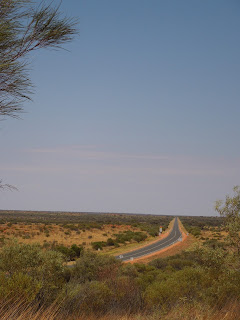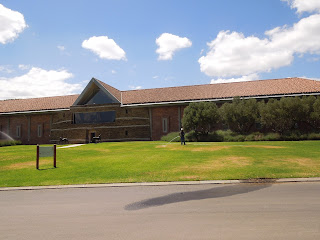‘The thing about being a small boutique winery,’ says one
cellar manager. ‘Is that we choose when
to pick the grapes ourselves. No one
tells us when to do it.’
 |
| Peterson's - a boutique winery |
Hunter Valley is full of boutique wineries. These are small vineyards, where the crop is
lovingly grown and the wine is made according to the crop. It means that their wines vary from year to
year, depending on how the crop turns out.
And it can vary tremendously.
‘You don’t normally associate Hunter Valley with cabernet
sauvignon,’ we were told at McLeish Estate. ‘But we had
perfect conditions in 2009 that we made some.’ We tried it, loved it, bought a bottle. $22, what we'd expect to pay for a good wine in the UK.
By making their wines according to crop, boutique wineries
offer something unique. Not the reliable
but same-old of the ‘industrial’ vineyards, which have no choice but to keep on
churning out the same wine year after year in order to satisfy the supermarkets,
or go bust. Boutique wineries invite you
to compare the 2010 semillon with the 2011 (‘we picked our crop early that
year, because of the weather – if we’d left it later, the wine would have been
too sweet’). They explain how their
blends differ from year to year (we called this the quartet because it has four
varieties – it’s unique). They tell of
how they spend hours swirling and spitting until they have the blend just right. More of this, less of that, different from
last year and the year before.
When you go into a boutique winery, you are asked what sort
of wine you like. ‘Ah, then try this,’
they say. ‘See what you think and I’ll
tell you what it is.’ Or, ‘You should
have this one with pasta, this one goes beautifully with lamb. Can you taste the smokey bacon in this one?
To me it’s like English breakfast.’
Actually, I got sausages with that one. So he took my glass, gave it a good sniff and
said, ‘Ah, yes, I see what you mean.’
 |
| Kevin Sobels wines - only available at the cellar door |
Some boutique wineries are so small they only do cellar door
sales – you can’t even buy them at the local bottle shop. It was at one of these, Kevin Sobels wines,
that we tried a rather lovely 2012 semillon (the one that was picked early) and
bought it. We drank it on it’s own that
night. Having been in the car all day,
it wasn’t quite as cool as we’d like, but it was still excellent (the sign of a good white, by the way, is
that it still tastes good when it’s warm).
And the thing about this Semillon, is that there was only so much of it
made and those exact conditions may never happen again, so we were drinking
something rather special. (It cost $22,
which is what we’d expect to pay for a good bottle back home).
 |
| Hunter Valley |
‘Ah, I see he’s spraying over there.’
This was said of the winery on the hill opposite Peterson’s
(where they hardly ever make a cabernet sauvignon, but when they do its damn
good). And he said it because it was a
humid day, there were still about 10 days before picking and the spray was to
prevent the mould that loves humid conditions.
‘He picks earlier than us,’ we were told. ‘Because he gets the morning sun.’
It’s not just the picking time, but the end result that is
affected by where grapes are grown. You
can get a different flavour from two different areas in the same
vineyards. And this is what wine-makers
love – they check conditions, they know their grapes and then they craft the
best wine they can from them. And each
year is a new challenge.
And that bottle of Semillon was beautifully crafted.






































